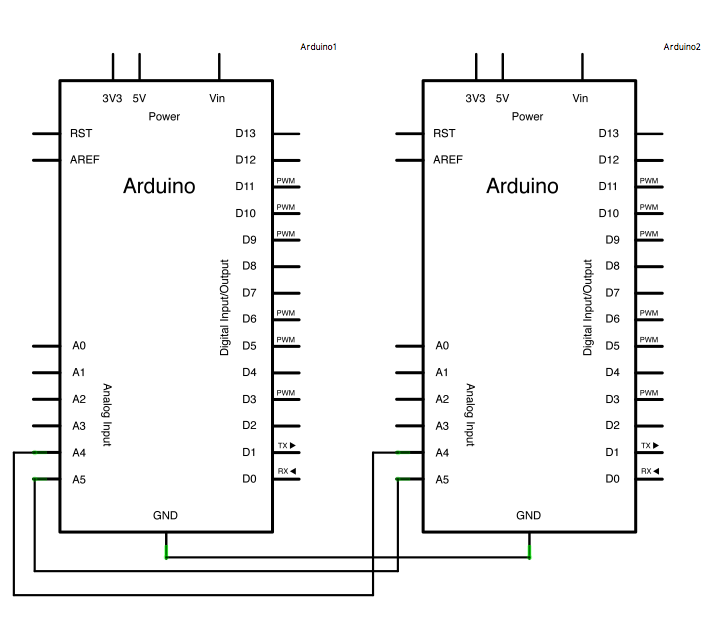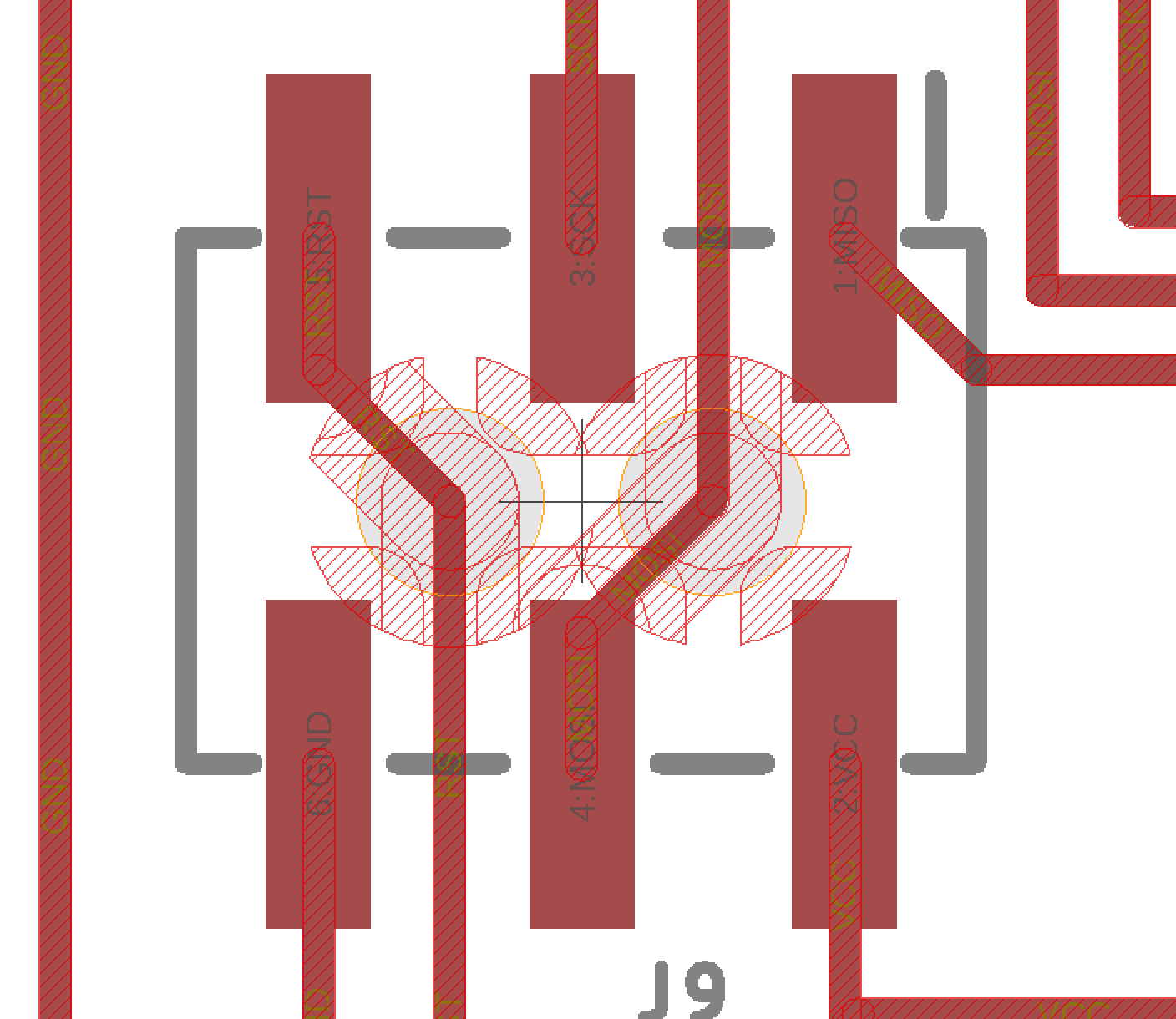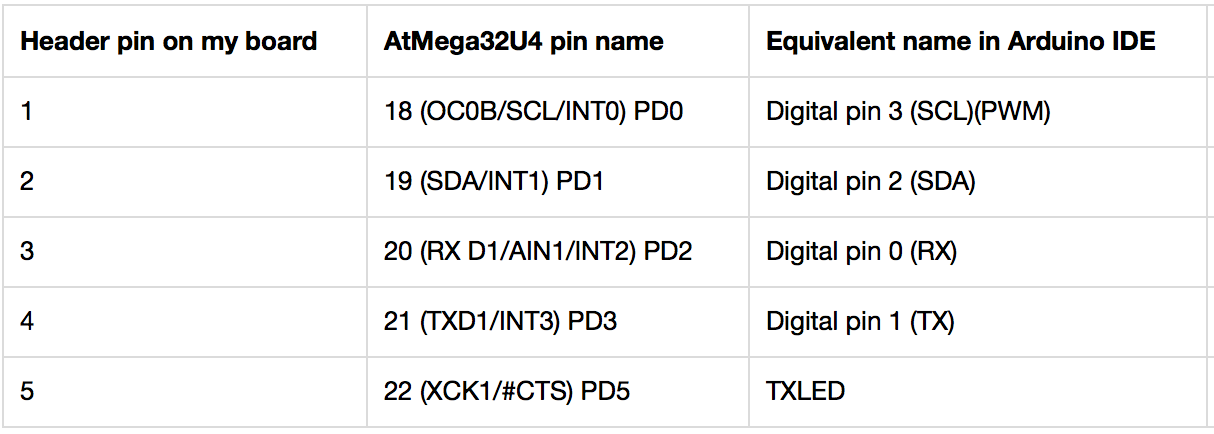Week 14 - Networking and communications
Tests of I2C communication on Arduino (and DIY Arduino-style) boards
Experiment 1: Connecting 2 Arduino boards
I used a commercial Arduino Uno and Arduino Pro Miny board together with demo files from the Arduino Wire library for I2C. I connected my 2 boards as per the schematic on the example code page:

The serial clock pin (SCL, 5) and serial data pin (SDA, 4) are connected between each board, as are GND, but because the Pro Mny runs at 3.3V, I used the 3.3V VCC on the Arduino Uno to connect VCC.

I was able to get these two boards to communicate sending serial data (characters) back and forth (using the same code as experiment 2, below).
Experiment 2: Connecting an Arduino to my Input Devices board
The board I made for the Input Devices assignment is essentially an Arduino Leonardo, so I was able to replicate the first experiment with these two boards using the same code. I just had to figure out how to access the pins on my board. Some of these are exposed on the ISP header.

- VCC: ISP header bottom right
- GND: ISP header botom left
The I2C pins themselves are exposed on my 5-pin header

Using the same code as before (attached below), I was able to send data back and forth again.

Experiment 3: Trying another way to control my Input Devices board
While these experiments showed I was able to communicate between the boards, I wanted to try one more test, to see if I could use a physical input on one, to control an output on another. So I wired up a buton to my Arduino Uno, and adapted some of the demo code so I could use it to control an LED on my Input Devices board.

My previous code used Wire.requestFrom() and Wire.onRequest() to request and listen for data:
Master:
void loop() {
Wire.requestFrom(7, 6); // request 6 bytes from slave device #7
while (Wire.available()) { // slave may send less than requested
char c = Wire.read(); // receive a byte as character
Serial.print(c); // print the character
}
delay(1000);
}
Slave:
void setup() {
Wire.begin(7); // join i2c bus with address #7
Wire.onRequest(requestEvent); // register event
}
void loop() {
delay(3000);
}
// function that executes whenever data is requested by master
// this function is registered as an event, see setup()
void requestEvent() {
Wire.write("hello "); // respond with message of 6 bytes as expected by master
}
My new code uses Wire.beginTransmission() and Wire.endTransmission() on the master to send the commands to the slave:
Master:
void loop() {
// read the state of the pushbutton value:
buttonState = digitalRead(buttonPin);
if (buttonState == 1) {
// turn LED on:
Wire.beginTransmission(7); // address of slave is 7
Wire.write(1); // sends value byte
Wire.endTransmission(); // stop transmitting
} else {
// turn LED off:
Wire.beginTransmission(7); // address of slave is 7
Wire.write(0); // sends value byte
Wire.endTransmission(); // stop transmitting
}
}
Slave:
void setup() {
// initialize the LED pin as an output:
pinMode(ledPin, OUTPUT);
digitalWrite(ledPin, LOW);
Wire.begin(7); // join i2c bus with address #7
// Attach a function to trigger when something is received.
// From http://www.instructables.com/id/I2C-between-Arduinos/
Wire.onReceive(receiveEvent);
}
void receiveEvent(int bytes) {
x = Wire.read(); // read one character from the I2C
}
void loop() {
if (x == 0) {
digitalWrite(ledPin, LOW); // received an OFF command
}
if (x == 1) {
digitalWrite(ledPin, HIGH); // received an ON command
}
}
Here’s a video of it working:
Group assignment
We used I2C to communicate between different boards from the group
Files
Experiments 1 and 2: sending serial data back and forth:
Experiment 3: sending a command from master to slave: